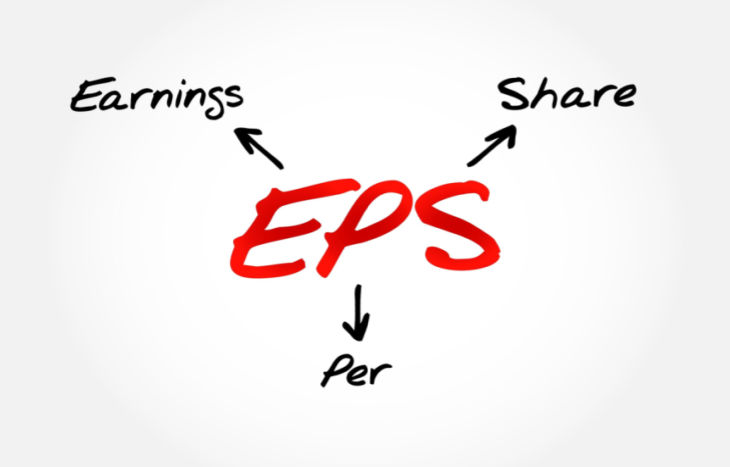Earnings Per Share Formula and EPS Example

The earnings per share formula is useful for valuing stocks. It’s a key part of the widely-used price-to-earnings ratio. And by gaining a better understanding of these concepts, you can make better investment decisions.
Let’s first take a look at how to calculate earnings per share (EPS). Next, we’ll look at an example and how to use the metric to make better decisions. With all financial formulas, it’s good to look at the larger picture and how they work together…

Earnings Per Share Formula
Here’s the earnings per share formula and let’s break down each piece…
Earnings Per Share = Net Income / Shares Outstanding
To calculate earnings per share, you need to start with Net Income for the company. And to find a company’s net income, you can look at their recent filings on the SEC website. You’ll find net income on a company’s income statement. And most large financial sites, such as Google Finance, provide this info as well.
Now that we have total net income, we need to find the company’s total Shares Outstanding. And you can also find this number in SEC filings or on most large financial sites. It’s how many shares a company has issued and investors are holding onto. Each share represents partial ownership in the company.
When using these numbers with the earnings per share formula, simply divide total net income by total shares outstanding. Although, what does the result mean?
If you own one share in the company, it shows you the earnings for that single share. And to be clear, the earnings don’t go directly to the investors. A company will often reinvest its earnings to continue operations and grow the business. However, some companies also return some of their income to investors via buybacks and dividends.
EPS Example
Let’s use Apple (Nasdaq: AAPL) as a real example. In its most recent quarterly report, it shows a total net income of $19.44 billion. And the company has recently reported 16.07 billion total shares outstanding. So, here’s the earnings per share formula with these numbers…
EPS ≈ $1.20 ≈ $19.44 billion / 16.07 billion shares
Apple’s quarterly earnings per share comes in around $1.20. This number gives a good look at the company’s profitability relative to each share. And for even better insight, it’s good to calculate EPS in other recent quarters, as well as going back multiple years. This can help you see trends in profitability and if the company is diluting existing ownership by issuing more shares.
More to Consider with Earnings Per Share
The earnings per share formula can give some great insight into an investment. Although, since earnings comes from the bottom of the income statement, there are many adjustments to get to tthat number. And one major issue is that non-cash items impact earnings.
For example, depreciation and amortization expenses are non-cash items. They can lower what a company reports as net income. Although, they don’t reflect the same changes in real cash flows for the company. To get around this downside, you can use other metrics such as free cash flow and compare that to total shares outstanding.
One other issue that we’ll often see with EPS comes from stock splits. A company might split – or reverse split – its number of shares outstanding for many reasons. And this can have a big impact on earnings per share.
For example, if Apple did a 2-for-1 stock split, the total number of shares would double. And since net income wouldn’t change, you’re dividing that same number by twice as many shares. As a result, the EPS would be cut in half.
That’s why it’s important to adjust for stock splits over time and many financial sites do this for us. Otherwise, the changes in EPS aren’t as reliable. And on top of stock splits, keeping an eye on other changes to shares outstanding is useful.
If a company buys back a lot of its stocks, this lowers total shares outstanding. As a result, it also increases earnings per share. And this isn’t necessarily a bad thing, but it’s good to pay attention to. Some incentive structures have factored in improvements to EPS. So, some management teams would buy back shares at less ideal times.
More Investing Insight and Opportunities
Gaining a better grasp of the earnings per share formula can help you make better investment decisions. It’s a key metric used in other valuation ratios such as the price-to-earnings ratio. And there’s always more to learn…
Here at Investment U, we strive to help anyone improve their financial literacy. No matter your level of investing, there’s something for everyone. For example, check out our investment calculator. It’s a free tool that can show you how your investments might grow in the years ahead.
And on top of that, we strive to deliver some of the best investment opportunities. To learn more, check out these top investment newsletters. They’re free and packed with insight from investing experts.






